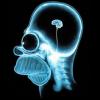@twindaddy37: for me it's not so much a question of what i stack with it, rather what i don't. for example, i find an nsi-cycle is better without much of caffeine usage.
tianeptine and phenibut and stuff like that i dont take with the nsi...
on the other hand i use a lot of stuff for overall body health, but it does not have anything to do with the nsi... magnesium, zinc, vitamin d, iodine... i use up to 10 grams fishoil per day... i use gynostemme extract 2-3 times a day. creatine daily...occasional liposomal vitamin c, i use citrulline-malate a few times per week. fasoracetam a few times per month... niacin (the flush version, 500mg on empty stomach with orangejuice) 1-2 times per week. MSM daily... ALCAR, NAC daily (!!)... chlorella... and guess what i also use MMS now...
maybe look into citrulline, fasoracetam and gynostemma extract... 1g of fish oil is not a lot.
why do you take the uridine ?
My mission is one of creating a highly resilient mental space so that my mind can heal from past damages (8 years of heavy narcotic abuse, and lots of them while living an extremely fast paced lifestyle that was filled with chronic stress that beat my body and mind into the ground). I have experimented for two years to find the perfect combination of substances that has made me most resilient to my life stressors- and i take the appropriate actions to grow both spiritually, emotionally and mentally. The damage left me with some pretty gnarly imbalances, namely alot of constant worrying, a flat mood and alot of negative self talk. I did manage to fix this and live in a pretty decent headspace for about 7 months, without anything. Then i was living on own and stress was little. Out of blue i was blessed with twin girls, and my life became VERY hectic again- so i needed fortification. My mission to fix the physical, nutritional and mental imbalances led me to finding an appropriate stack that works best with my chemistry, that gives me no side effects- and this is what i have settled on. I have used most of the adaptogenic herbs, gynostemma ect. I find that anything over 1 gram of fish oil hurts my libido and it is afterall a PUFA, which is why i limit my dosage of fish oil. Also like stinkornijor said, i found that fish oil in excess hurts mood. I also take MCT oil, which i think is healthier. I have not tried fasoracetam whats the benefit of this substance? Doesnt NSI have a niacin like component to it? The only niacin i get is in a multi. MSM did nothing for me. I do take mag citrate every three days before bedtime. I try not to overdo anything and strive for balance. My goal is to build stress resilience, which is why i also do some cold exposure therapy. I figure if i can create a headspace where i am simply (mostly) living in the present, my mind will have the optimum potential to grow and rewire where there was damage from the past. I cut out all media, social media, news, politics, groups of people with opinions, commercials and just INFORMATION in general, aside from this forum, so that i can learn to live through my intuition again, and i find there has been ALOT of growth in doing so.I also "minimized"- got rid of shit i didnt need or use basically to simplify. Uridine i use for dopamine receptor modulation. I use phenibut on the weekend one day as a tool to be as social as possible, so i can flex the social muscles.
NSI-189 does indeed have the niacin core structure (pyridine-3-carboxyl moiety) embedded in it, but I don't think that would confer any niacin-like activity to it because NSI-189 is so modified (i.e. the amine group in the 2-position, which is unlikely to come off metabolically). Out of curiosity, what brand of fish oil do you use? I too have noticed a decrease in libido, but I've always attributed that to my taking a relatively high dose of Cymbalta twice daily.
























































